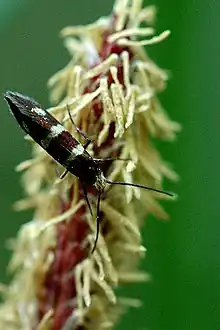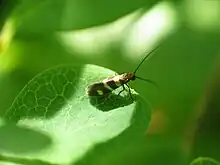| Micropterix aureatella | |
|---|---|
 | |
 | |
| Scientific classification | |
| Domain: | Eukaryota |
| Kingdom: | Animalia |
| Phylum: | Arthropoda |
| Class: | Insecta |
| Order: | Lepidoptera |
| Family: | Micropterigidae |
| Genus: | Micropterix |
| Species: | M. aureatella |
| Binomial name | |
| Micropterix aureatella | |
| Synonyms | |
| |
Micropterix aureatella is a moth of the family Micropterigidae found in the Palearctic realm (from Europe to Japan), except for North Africa.
Taxonomy
The moth was first described from a specimen found in Carniola, present-day Slovenia, by the Austrian physician and naturalist Giovanni Antonio Scopoli in 1763.[2] He named it Phalaena aureatella. Phalaena – a word used by Aristotle, meaning the rest of the moths; or possibly a devouring monster or whale, which may be derived from the destructive properties of clothes moths; or possibly from phallus an association by the Greeks of lepidoptera and semen which was supposed to attract moths; or paros i.e. a light and the attraction of moths to lights. The moth was later put in the genus Micropterix, which was raised by Jacob Hübner and the name comes from the small size of the adult; Mikros – ″little″ and pterux – ″a wing″. The specific name aureatella – golden from aureatus, referring to the three submetallic markings on the forewing.[3]
Tinea merianella [Denis & Schiffermüller], 1775 is most probably a synonym of Micropterix aureatella, which is the only purple moth with three golden transverse fasciae within the federal territory of Vienna. The type of T. merianella was destroyed in the Hofburg fire in 1848 and it is thus hard to determine if the species is indeed a synonym.
Subspecies
- Micropterix aureatella aureatella
- Micropterix aureatella junctella Weber, 1945
- Micropterix aureatella shikotanica Kozlov, 1988
Description
The wingspan is 9–11 millimetres (0.35–0.43 in). The head is yellowish and the base colour of the forewings is purple or bronze with two golden bands and an oval spot towards the wingtip.[4] The adults have working mandibles and feed on the pollen of a variety of flowers, especially those of sedges (Carex species).[5]
- Larva
A single larva has been found amongst fungal hyphae in mixed beech, bilberry and oak leaf litter.[4] The larvae are believed to feed on bilberry (Vaccinium species).[5]
- Pupa
The pupa is unknown.[2]
References
- ↑ "Micropterix aureatella (Scopoli, 1763)". Fauna Europaea. Retrieved 1 November 2021.
- 1 2 Heath, John (1983). Micropterigidae. In The Moths and Butterflies of Great Britain and Ireland. Volume 1. Colchester: Harley Books. p. 153. ISBN 0 946589 15 1.
- ↑ Emmet, A Maitland (1991). The Scientific Names of the British Lepidoptera. Their history and meaning. Colchester: Harley Books. pp. 18 & 42. ISBN 0 946589 35 6.
- 1 2 Sterling, Phil; Parsons, Mark; Lewington, Richard (2012). Field Guide to the Micromoths of Great Britain and Ireland. Milton-on-Stour: British Wildlife Publishing. p. 47. ISBN 978 0 9564902 1 6.
- 1 2 Kimber, Ian. "Micropterix aureatella (Scopoli, 1763)". UKmoths. Retrieved 1 November 2021.
- Zeller-Lukashort, H. Christof; et al. (2007). "A review of Micropterix Hübner, 1825 from northern and central Europe (Micropterigidae)" (PDF). Nota Lepidopterologica. 30 (2): 235–298.
External links
- www.lepiforum.de: Taxonomie and Photos
- Micropterix aureatella at Naturhistoriska riksmuseet
- Meyrick, E., 1895 A Handbook of British Lepidoptera MacMillan, London pdf
 This article incorporates text from this source, which is in the public domain. Keys and description page 806
This article incorporates text from this source, which is in the public domain. Keys and description page 806